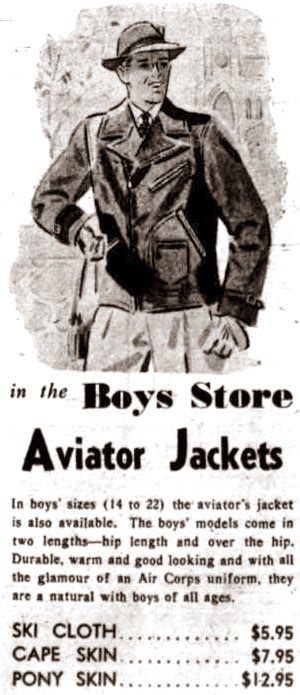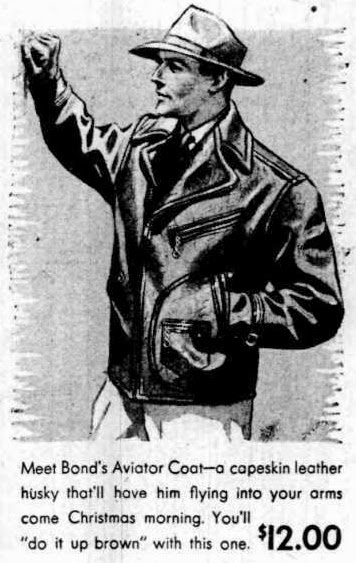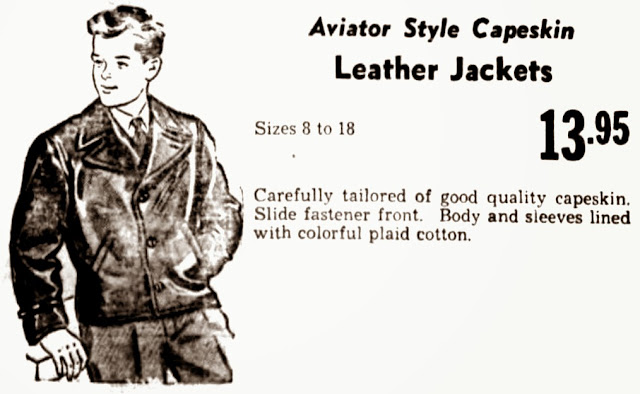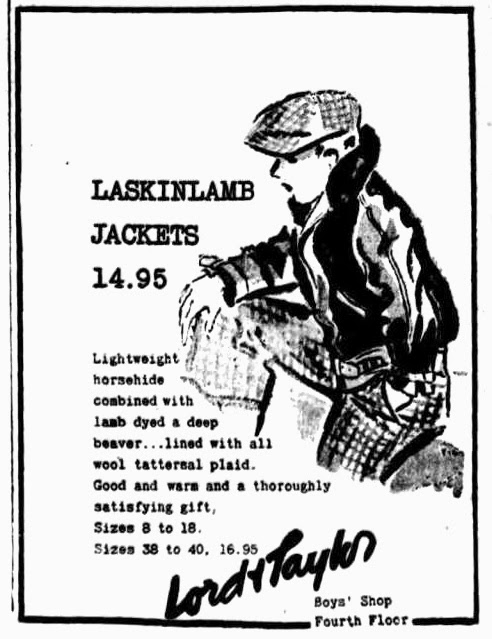FRENCH CANCAN: Brother can you spare a dime (part 2): Hobo nickels… The altering of coins dates to the 18th century or earlier. Beginning in the 1750s, the most common form of coin alteratio...![]()
↧
FRENCH CANCAN: Brother can you spare a dime (part 2)
↧
Inspiration 2012; All Aboard the Queen Mary
Its that special time of year again. Clothing companies head west to Las Vegas for Magic and Project. Gigantic shows where little and big fashion brands alike get to show off their wears. It is also the time of year where I travel to Inspiration one more time to meet up with all the brethren and sistren that make up the crazy world of vintage dealers, vintage designers, fashion brand owners, collaborators and store owners. Where else will you meet designers for Levis, Woolrich, and the biggest brands in the world, hanging out with surfers and photographers.
Inspiration is the brainchild of Rin Tanaka. Rin spent years networking with the best vintage collectors on the planet in England, Canada, Japan and the U.S.A. photographing their wears and publishing some of the finest books on the topic. His genius was to organize Inspiration, a culture jam where designers, vintage dealers, musicians, surfers, shoppers, gurus, and the like can all meet up hang out and exchange ideas. My brand Himel Brothers will be there, so will vintage king Larry Heller, Zip Stevenson of Hollywood Trading Co., my good friend Eric Schrader of Junkyardjeans. As well I will be travelling with Brett Viberg of Viberg Boots, and schmoozing with old and new friends alike. The list goes on and on but the
best way to see who is showing there is to go to Rin's website and look at the ship map. Never mind the ship itself is absolutely beautiful!!!! So come on down and check out the show and jump over to the website at Inspiration 2012 and check out the show. Ultimately if you are interested in buying or seeing some of the most innovative designs or rarest vintage on the planet this is the place to be!!!!! I will post ...post show for those of you who cannot make it down and offer an insiders view! Check out the newest coolest magazine launching at the show.....Clutch Magazine which will feature Himel Brothers amongst other fantastic brands!!!!
![]()
Inspiration is the brainchild of Rin Tanaka. Rin spent years networking with the best vintage collectors on the planet in England, Canada, Japan and the U.S.A. photographing their wears and publishing some of the finest books on the topic. His genius was to organize Inspiration, a culture jam where designers, vintage dealers, musicians, surfers, shoppers, gurus, and the like can all meet up hang out and exchange ideas. My brand Himel Brothers will be there, so will vintage king Larry Heller, Zip Stevenson of Hollywood Trading Co., my good friend Eric Schrader of Junkyardjeans. As well I will be travelling with Brett Viberg of Viberg Boots, and schmoozing with old and new friends alike. The list goes on and on but the
best way to see who is showing there is to go to Rin's website and look at the ship map. Never mind the ship itself is absolutely beautiful!!!! So come on down and check out the show and jump over to the website at Inspiration 2012 and check out the show. Ultimately if you are interested in buying or seeing some of the most innovative designs or rarest vintage on the planet this is the place to be!!!!! I will post ...post show for those of you who cannot make it down and offer an insiders view! Check out the newest coolest magazine launching at the show.....Clutch Magazine which will feature Himel Brothers amongst other fantastic brands!!!!

↧
↧
Rivet Head: Inspiration Vol. 3 x Himel Bros.
↧
Wool, Leather, and Canvass: Spring is Coming
Well the winter never really came this year. I am behind on my posting. I really feel badly about it but my Himel Brothers brand has been eating up all my time. I am making a quick post to celebrate some of the most lovely mixed media I have seen in a while. Mixed media really refers to the elements that make up a jacket that are not as much aesthetic as a way to combine natural materials to cope with differing service needs. In the days before synthetics, combining different organic materials often adapted jackets and outerwear to handle more inclement conditions. One of my brilliant Swiss customers sent me this Heron he purchased and broke in. It has a great patina but more importantly I combined original 1930s wool blankets to create a vintage liner to the jacket for extra warmth. These types of modifications were often done by workers in the 1920s and 30s to make their jackets more practical for service. This Heron can be purchased at VMC Originals in Zurich.
This tradition of using leather as a reinforcement is a real heritage. Pre 1900 leather was often used as a liner to wool jackets. Odd but true, the smart design of the 1930s reversed this theme and outerwear makers realized leather really deserved to serve as reinforcement on high wear areas. Check out the Montgomery Ward coat, the leather shows up on all the high wear zones increasing durability.
The leather elbow pads almost appear to be similar in design and construction to 1960s flat track racing jackets by Bates, Lancer, Abc and other great racing companies. Same idea different era.
Wool for warmth, Canvas for waterproofness and light weight and leather for wear, as leather becomes quite hard on its own in extreme cold.
↧
Locavoirs, Leather and Mindfulness....
Part of the great struggle of both the vintage leather business and the new leather business is that of ethics. Mindfulness is that process of becoming aware of the self and seeing all things as interconnected. The local food movement is an example of mindful shopping where participants prefer to buy from local producers where they know the source of their food and how it was grown vs. buying by price. Oddly my leather jacket project Himel Brothers has taught me valued lessons on the kinds of problems that indigenous manufacturers may have faced as they progressed their business. Every day I get 2 to 3 emails and spams to this blog from Pakistani leather manufacturers offering to make me jackets from my patterns for the price of 47-57 dollars per jacket. How wonderful! I cannot even pay for the leather in one jacket at that price. It makes for a very interesting debate amongst my customers and my retailers about costs and pricing.
Now I generally don't think anything I make is average. Certainly I aspire to not only achieve the quality and character of my vintage collection in my new jackets but I am also trying to achieve the zen nature and longevity that original jackets imbued. Environmentally speaking I have to know each of my suppliers, and design perfect life long lasting styles that are made of ethical materials. While not 100% local in the sense of coming from my neighborhood or Province, each supplier is vetted for what they are making and how they are making. Perhaps the differences between lovingly grown horses, slaughtered and gently treated and then vegetable tanned in tree bark in Japan is not always
readily apparent to the consumer? The jackets are not indestructible, nor do they glow with electronica or transport the wearer to another planet. Simply put the pressures for me are to make perfect technical replicas out of organic materials and not be the guy using my skills and knowledge to make 47 dollar jackets in Pakistan and sell them for half of what I am currently doing. People ask me why and how I do things. I think to myself...I make life long lasting, beautiful, well made, well sourced organic jackets that like my vintage collection will age and die gracefully. It is something to think about when you are buying your next 200 dollar made in (where ever) jacket...all that energy and all the negativity that goes into making something cheaply will be worn right on your back! Producers back in the day sought to be price competitive whilst increasing features, branding and quality. Old makers reached the pinnacles of that paradigm and new competitors could only compete on pricing. It was that downward push on pricing via cheaper imports and a less educated consumer that lead to the extinction of domestic garment makers. How sad really because the consumer actually stopped caring about what they were wearing and chose simulated fashion, or simulated quality in deference to price!
Now I generally don't think anything I make is average. Certainly I aspire to not only achieve the quality and character of my vintage collection in my new jackets but I am also trying to achieve the zen nature and longevity that original jackets imbued. Environmentally speaking I have to know each of my suppliers, and design perfect life long lasting styles that are made of ethical materials. While not 100% local in the sense of coming from my neighborhood or Province, each supplier is vetted for what they are making and how they are making. Perhaps the differences between lovingly grown horses, slaughtered and gently treated and then vegetable tanned in tree bark in Japan is not always
readily apparent to the consumer? The jackets are not indestructible, nor do they glow with electronica or transport the wearer to another planet. Simply put the pressures for me are to make perfect technical replicas out of organic materials and not be the guy using my skills and knowledge to make 47 dollar jackets in Pakistan and sell them for half of what I am currently doing. People ask me why and how I do things. I think to myself...I make life long lasting, beautiful, well made, well sourced organic jackets that like my vintage collection will age and die gracefully. It is something to think about when you are buying your next 200 dollar made in (where ever) jacket...all that energy and all the negativity that goes into making something cheaply will be worn right on your back! Producers back in the day sought to be price competitive whilst increasing features, branding and quality. Old makers reached the pinnacles of that paradigm and new competitors could only compete on pricing. It was that downward push on pricing via cheaper imports and a less educated consumer that lead to the extinction of domestic garment makers. How sad really because the consumer actually stopped caring about what they were wearing and chose simulated fashion, or simulated quality in deference to price!
↧
↧
Aviator Jackets and the D pocket: part 1
This jacket was advertised in 1939 by Penney's. As with many jackets of this aviator style, it was made of capeskin. This one featured a "sports back" and half belt, with yoked shoulders, and button cuffs. The outstanding detail of this particular model would have to be the map pocket. This large patch pocket would later evolve into the D-pocket found on certain motorcycle jackets of the 1940s-1960s.
This sort of top-loading map pocket with a smaller patch cigarette pocket would later become more associated with motorcycle jackets, like the one below.
↧
Aviator Jackets and the D- Pocket: Part 2
Aviation Jacket ad from 1940. Not surprisingly, made of capeskin leather. I find it interesting the asymmetrical and sloppy ways the lapels on these jackets are often illustrated. I guess it's like how sheepskin lined jackets are usually drawn with the tails blowing in the breeze to show the lining.
In person, the differences would be clear, but from the advertising picture, the overall details are extremely similar to D-pocket motorcycle jackets made twenty years later.
Early 1950s British Mfg. Co. D-Pocket motorcycle jacket. These Canadian made jackets were close copies of Harley Davidson Cycle Champ motorcycle jackets, which owed a great deal of their design influence to these aviation styles.
↧
Aviator Jackets and the D Pocket: Part 3
Here is yet another style of map pocket employed on these Aviation jackets which carried over onto later motorcycle jackets. This variant had an inset pocket, with a stitched outline. The zippered top opening opened at an angle. The jacket below was advertised in 1941. It was made of capeskin, and had two large zippered pockets and a small "match pocket" overtop the map pocket.
1960s Star Sportswear Kurland, with the same style pocket design
↧
Aviator in the flesh
This jacket was loaned to me for photos by a friend. His father bought it just after the close of WWII and wore it for riding motorcycles for years. It is capeskin leather, with a simple half-belt back. The pocket arrangement, with hand-warmer pockets and a breast pocket is also simple for this type of design. Many manufacturers fell into the game of "how many zipper pockets can we put on the front of this thing?". Although it looks in the photos like the jacket has epaulettes, that's just the shoulder stitching going bad. The zipper is a transitional brass Talon, consistent with the immediately post-war dating, with a small-hole slider and a U shaped Talon marked stopbox. The jacket's tag is long since missing, and no one can remember what it was. The jacket has a plaid cotton lining, but the plaid in the body and in the sleeves is mis-matched.
↧
↧
1942- Full Features
↧
Foster Sportswear Aviator Jacket
This one was made by Foster Sportswear, probably just after the war. It's capeskin, as is typical for this style. The combination handwarmer/flap pockets would seem more at home on a belted surcoat length leather jacket, but the diagonal map pocket is all aviator. Elastic sides, plain back, decorative buttons on the cuffs.
↧
Aviator ski jackets
The ad below, dating from 1939, is interesting for a number of reasons. First is the pocket. It follows the conventions of what would become the d-pocket, with the curved stitching and the smaller cigarette pocket, but is flipped, with the opening functioning as a handwarmer pocket. This general scheme, in a symmetrical setup had been around since the 1920s, without the sub-pocket. Is this just a variation on a pocket style, or a stepping stone on the way to the motorcycle jacket d-pocket of the postwar years?
The ad is also interesting regarding the jacket length. This style is best remembered as a waist or hip length- a short style. But they were also offered in longer, "over the hip" styles. This ad, along with many others of the period, equate this "aviator" style with the jackets worn by the Army Air Corps, despite having very little in common design-wise. Although the "aviator" name for this style survived until about 1946, after the war, it would be applied to civilian variations on the A-2
The ad offers this aviator jacket design in both leather and in "ski cloth". Many leather jacket designs of this period and the decades before were offered both in leather and in wool, so it's no great surprise to see it in non-leather materials. It is interesting, however, to see the crossover between this jacket style and ski jackets. In essence, both were double breasted coats cut down to waist length, but I don't think I've ever seen such a direct link. Below are double breasted ski jacket styles from 1941 and 1942.
↧
Aviator Jackets and the D Pocket : Part 4
↧
↧
Button Aviator
↧
Silver Canadian D-Pocket motorcycle jacket
This motorcycle jacket was made in Canada, probably by the British Manufacturing Company (later British Cycle leathers, later Brimaco). The basic design takes heavy influence from the Harley Davidson Cycle Champ style. This is one of the earliest Canadian-made versions I have seen. It has early bell-shaped Lightning zippers. The epaulettes are stitched down, whereas later versions had snaps at the end. It has a large D-pocket, with smaller flapped patch pockets. The Cuffs zip open, while later versions have a leather expansion gusset inside. The cuffs snap closed over the zipper to make sure they are truly closed. The jacket has factory studwork reinforcement at all pocket corners and on the epaulettes. The silver color of the leather on this one is truly unusual- for a rider who wanted a bit more flash than the usual black.
↧
Three Generations of Albert Richard Mackinaws
A brief recap on the history of the company- the full writeup can be found here:
Albert Richard's parent company opened in 1902 as a glove manufacturer, and began making leather jackets in the 1920s. They were also known for their wool sportswear. In the 1950s, they were bought out by hunting garment manufacturer DryBak, who relocated their factory several times, and eventually dropped the line.
As luck would have it, I have three different generations of their blanket mackinaw in my hands right now. The one at left, a mid 1930s model made from "multi-stripe" Hudson's Bay point blanket material is my go-to winter coat out here in Bozeman, Montana. Pictures of it can be found here: http://vintageleatherjackets.blogspot.com/2013/09/albert-richard-mackinaw-coats.html. As with many of these early mackinaw coats, it is unlined, but the early blankets were extremely thick and heavy and came from the woolen mill with a thick nap, which gave them additional insulation. Although these blanket coats have never really disappeared, the bright colors certainly do draw attention- I get compliments and questions about it all the time.
Me wearing the multi-stripe Albert Richard coat on the left. It does its job well out here in Montana.
The coat in the middle also dates from the 1930s, but is slightly newer than the multi-stripe version. It has a larger Hudson's Bay company label, although the cut of the coat is basically the same. Albert Richard advertised the "Action Fit" on this version of the label in the late 1930s. I currently have it up for sale: http://www.ebay.com/itm/271323676616
Here's an example from the tail end of the original Albert Richard, dating from between 1946 and 1952- probably from later in that time frame. Albert Richard innovated the use of fiberglass as insulation in their coat linings, a technology borrowed from the construction of B-29 bombers. It's interesting that the tag puts their founding date as 1905, which coincides neither with the founding of parent company Fried-Ostermann or the introduction of the Albert Richard name. By this point, Albert Richard had switched away from the Hudson's Bay point blanket material to an unknown woolen mill's striped blanket material. It's a lighter weight wool, without the thick nap, and with a different stripe pattern than I have seen before. Blanket materials, particularly those by the Hudson Bay company were expensive. With the "Spun Sun" lining, Albert Richard could give the same warmth as the unlined 1930s example above with a less expensive wool.
It was around this time that the Hudson's Bay Company started having coats made specifically to be sold by their stores, instead of licensing their fabric for use by other companies, which probably also played a part in the material shift. Other blanket coats I have had from this 1950s period had the same shift away from thick shelled unlined construction. Interestingly, many of these companies were also well known manufacturers of leather jackets. See this Lakeland from 1947, this Lakeland from 1964, and this early 1950s Buck Skein.
↧
Spotlight on Grizzlies
With a crisp winter wind in the air, I think it's time to focus on the style of jacket that has come to be known as the "Grizzly". Watch this spot for a new post every day about this 1930s leather jacket style for the next while.
More details of this jacket can be seen here.
↧
↧
Origins of the Grizzly
For those who could afford it, fur was the best material in the constant battle between warmth and weight. It was the material of choice for high end cold weather motoring garments, as it was water and wind resistant and above all, warm. At this point, leather was used mostly for windproofing, and was often found on the inside of coats as a lining. Below is an ad from 1905 for a Russian ponyskin coat.
While most Grizzly Jackets were made of horsehide and mouton, early "Fur Blouses" truly were fur.
The Edes Robe Tanning Company was founded c.1905 by Canadian-born St. Clair Ede. The company once had locations in Dubuque, Iowa, Saint Paul, Minnesota, Omaha, Nebraska and Souix Falls, South Dakota. Their primary business was ponyskin lap robes for carriages and early open automobiles. As carriages were replaced by automobiles, and as car design became enclosed, the need for fur robes mostly evaporated. Faced with a changing market, Edes focused their attention on their fur coat business, producing fur coats for men and women under the King-O-FUR label. Unlike many furriers, Edes took styling cues from the new waist-length outdoorsman's leather jacket styles, but made them in the material they knew best- ponyskin.
Men's Pony Jackets by Ede's King-O-FUR. Waterproof and Mothproof.
Early jacket in the knit knecked style innovated by Summit in the 1910s.
Below: A 1927 King-O-FUR model. Ponyskin body with horsehide sleeves and trim. Made in a then-new cossack style with a snap front. King-O-FUR advertised their jackets as being practical in both extreme cold and in the heat.The jacket, with leather sleeves and trim and a fur body would catch on. Other companies began producing the style, modified with thick mouton panels instead of hair-on ponyskin, in the early 1930s, with the style peaking in popularity in 1937. King-O-Fur would introduce the slogan "Not an Imitation and Not Imitated". St. Claire Ede died in 1938 and the company was taken over by his widow Louise A Ede. The company was dissolved on November 15, 1939.
↧
Ede's King-O-Fur: Advertising and Adventure
Ede's King-O-Fur understood the marketing of rugged clothing. While other manufacturers of "Grizzly" jackets advertised their jackets like so:
![]()
King-O-FUR got endorsements from adventurers and real life action heroes.
1931: Hugh Herndon and Clyde Pangborn, shown with their plane, the Miss Veedol. They wore King-O-Fur jackets on the first non-stop flight across the pacific, from Japan to Washington State. Read more about their record breaking, and nearly disastrous flight here.
Photo of the Miss Veedol from the University of Washington
King-O-Fur jackets went with Chief Engineer Ralph Shaw and Chief Electrician Arthur C. Blumburg on submarine O-12, "The Nautilus" during Huburt Wilkins and Lincoln Ellsworth's arctic expedition of 1931. The submarine was originally slated to meet the Graf Zeppelin at the North Pole, but weather and mechanical problems prevented the rendezvous. The submarine was the first to dive under arctic ice. It was uninsulated and unheated.
On his King-O-Fur jackets, Shaw had to say: "Wish to express my appreciation and great satisfaction with the "King-o-FUR blouse. I was greatly surprised when it proved to be of such remarkable workmanship, beauty and warmth. I feel qualified to consider the blouse of the highest grade material". Blumburg said, "Having worn jackets of various types in submarines for the past sixteen years, I find that this King-o-Fur jacket is a combination of warmth and beauty. I take much pride in showing it to my friends. I do not hesitate to recommend King-o-FUR jackets to anyone".
More about the submarine here.
Hank O. Weber, outfitted with a jacket, gauntlets, hat, and sleeping bag all made by King-O-Fur. In 1927, Weber, "and his dog team of Irish Airedales are reported to have scaled Mt. Whitney and planted the American flag on top of the buried Smithsonian hut at the summit. This is the first time Mt. Whitney has ever been climbed with the aid of a dog team. Weber made several attempts, being driven back by intense cold and blizzards. He was lost once and found in a dazed condition by a rescue party" - Santa Cruz Evening News, May 16, 1927. Boots were custom made by King-o-Fur for Weber's Airedales to protect their paws on the ice.
↧
Laskin Lamb Jackets, 1934-1935
By about 1933, the "Grizzly" had found its form. The body was made of mouton. The sleeves, waistband and trim around the zipper were leather. Waists were belted.
Ad from 1934. Many of the earlier ones had this type of shawl collar, while later ones generally had shirt style collars. This example has raglan sleeves.
"Wool Bolivia" was a common lining material listed in these ads, but I'm not sure exactly what specific type, or weave of wool that trade name refers to.
Many ads for this style show it worn for skiing. While ads for other jacket styles of the period show them worn in casual, or in work settings, ads for Laskin Lamb jackets show them almost exclusively as sports jackets. Photos showing these jackets actually being worn generally show them in other contexts.
Cuffs that flip up and button, so that as the young owner of the Laskin Lamb jacket grows, the jacket grows with him.
Chunky tweed and a knit cap.
↧















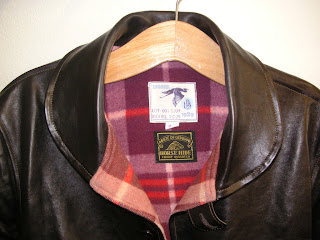























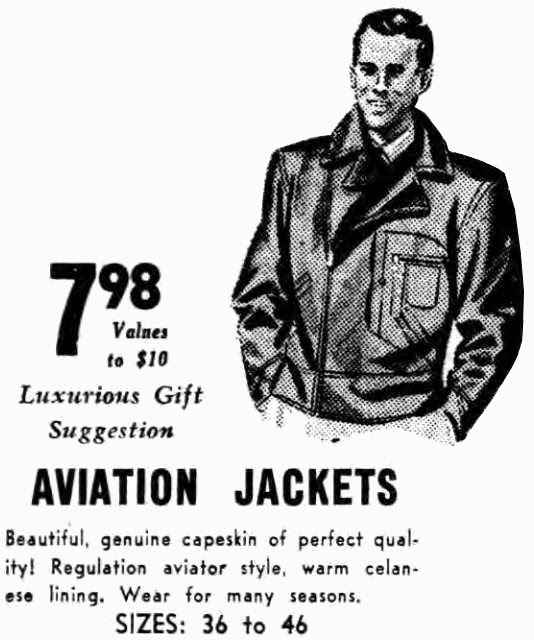

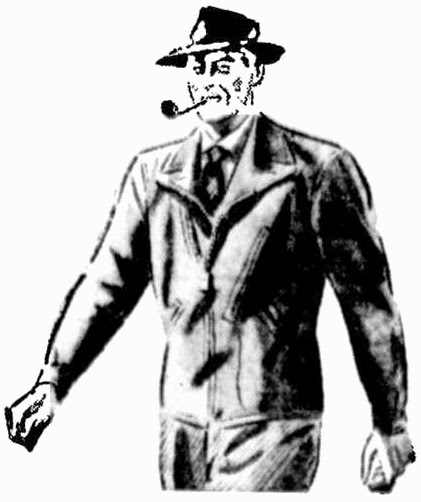

+-+Copy.jpg)
.jpg)
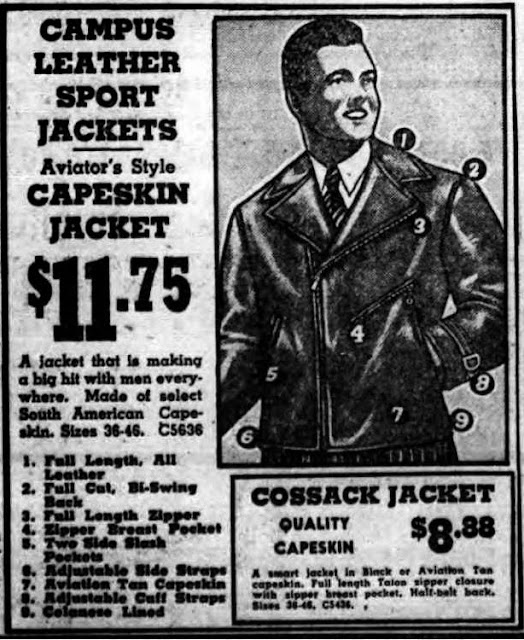
.jpg)
.jpg)



